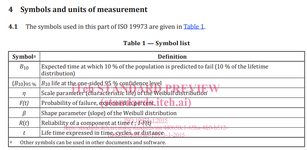Hi
What is mean by B10 life.
For example, B10 life is 1000 hours calculated from physical validation of part.
Scenario A:
Which means 10% of population may fail BEFORE 1000 hours.
In a population of 100 parts, 10 parts may fail BEFORE 1000 hours.
10 parts failure may be at. 100, 200, 300, 400, 500, 550, 600, 800, 900, 950 hours. (leaving the calculation aside, for my understanding)
Scenario B:
Which means 10% of population may fail AFTER 1000 hours.
In a population of 100 parts, 10 parts may fail AFTER 1000 hours.
10 parts failure may be at. 1100, 1200, 1300, 1400, 1500, 1550, 1600, 1800, 1900, 1950 hours. (leaving the calculation aside, for my understanding)
Kindly clarify.
Thank you.
What is mean by B10 life.
For example, B10 life is 1000 hours calculated from physical validation of part.
Scenario A:
Which means 10% of population may fail BEFORE 1000 hours.
In a population of 100 parts, 10 parts may fail BEFORE 1000 hours.
10 parts failure may be at. 100, 200, 300, 400, 500, 550, 600, 800, 900, 950 hours. (leaving the calculation aside, for my understanding)
Scenario B:
Which means 10% of population may fail AFTER 1000 hours.
In a population of 100 parts, 10 parts may fail AFTER 1000 hours.
10 parts failure may be at. 1100, 1200, 1300, 1400, 1500, 1550, 1600, 1800, 1900, 1950 hours. (leaving the calculation aside, for my understanding)
Kindly clarify.
Thank you.

